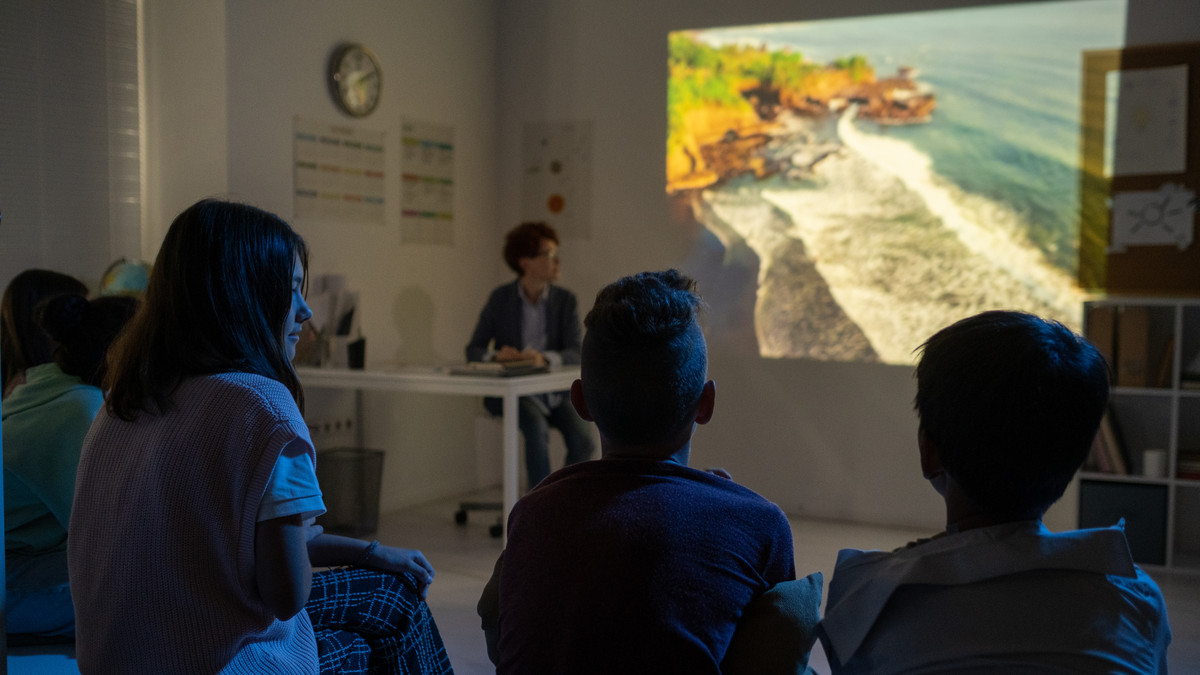Most of us remember at some point in our education a teacher who would wheel a TV into class, pop a video in the VCR, press play, and then take a literal or proverbial nap for the remainder of class time.
That’s exactly how not to utilize film, documentaries, or other video presentations in class, says Britton Barnes, a 7th- and 8th-grade social studies teacher at Clement Middle School in the Redlands USD in California. However, when used correctly – in short clips with educator-provided context – videos, films, and documentaries can be a way to enhance lessons while giving students a deeper understanding of topics ranging from science to history to media literacy.
Use video to support, not replace, the lesson
Incorporating video brings multimodality into your teaching, however, videos should be introduced with proper context, says Karen Beerer, Discovery Education’s senior vice president of teaching and learning. “I’m not necessarily sure that a movie by itself is a good enough learning experience for students,” she says. “So what are you doing with that movie? How are you handling the before, during, and after?”
Videos are best used to build on already existing lessons by providing another way to understand or connect with the material for students. “It’s one thing to see the photosynthesis process on a worksheet, or on paper, it’s another thing to visually see it,” Beerer says.
Barnes uses video to help his students form a deeper connection with history through historic clips and recreations that can help them connect with the material.
Keep videos short and model good viewing habits
While extended screenings may work once in a while, you generally want to keep it short, 15 minutes or under, and almost never want to devote an entire class session to a screening.
Beerer says research shows shorter clips are better, and it is easier to align a shorter clip both to your existing lesson plans and to students’ attention spans.
Some of the clips Barnes uses in his class can be as short as a minute or two, and rarely exceed a quarter-hour on a video or a single activity of any kind. “I don’t like to go over 15 minutes on anything. I like to keep moving,” he says.
Barnes also teaches students how to take notes and helps them keep an eye out for key takeaways. He’ll stop after five minutes and go over important bullet points or use an app such as EdPuzzle, which automatically stops the video to ask viewers questions. EdPuzzle can be used when students watch something at home, but Barnes also likes using it in class and having his students explore the questions as a group.
Examine the source and accuracy of films and videos
When screening documentaries, Barnes has his students source the video by asking questions such as:
- Who made this?
- Why did they make it?
- Is it relevant?
- Can I corroborate this information with something I’ve read?
“Then I always tell my students, we’re going to learn to be historians rather than learn history, right? Because those are skills you carry across all disciplines,” he says.
He has a similar approach when showing historical films.
“When we are using a Hollywood film, we’ll even play games like, ‘Is it history? Or is it Hollywood?’” Barnes says.
After guessing which film segments are real and which are created by screenwriters, students then research and confirm the changes Hollywood made. “The way you present can create a lot of excitement, and a lot of tension or drama, and interest,” he says.
Make sure the video screens, licensing are in order
Many educational services provide videos to teachers specifically for the purpose of screening in class. In general, showing a film at school for students is permitted under U.S. copyright law, but holding a public viewing with parents or other community members is not allowed. Check with a school librarian or with your technology or AV teams for best practices and institution policies.
In addition, many streaming services are blocked at schools, which might prevent you from streaming content on a school device. Remember, different devices within the same school may have different blocks, and permissions are constantly updated by schools and streaming services. So just because you successfully screened a clip using your Netflix account last semester, it doesn’t mean it will work this spring, especially if you switched classrooms and/or devices.
Let students share their reactions to the video and film
Educators can all too often influence how students react to a film screened in class, says Arnold Blumberg, an adjunct professor at the University of Maryland, Baltimore County, who regularly incorporates film into his classes. “It’s an easy pitfall, particularly as someone who’s probably far more steeped in the material than the students are, or has seen a given movie many more times than they’re likely to have seen it, to start imposing your perceptions on them,” he says. “And it’s important even as the teacher to not dominate the immediate reactions, and to allow these things to happen organically.”
That means establishing an environment in which all students feel comfortable reacting to the film in the way that they experienced it.
“It’s important to be open to the fact that students are going to have a lot of different reactions,” Blumberg says. “Their emotions are valid, and you want to talk to everybody and have a productive conversation, and not try to tamp down any of those reactions, and not try to tell them, ‘Okay, but here’s what you should think about that,’ or ‘here’s the right way to interrupt this.’ There’s no right way.’”
This article was written by Erik Ofgang from Tech and Learning and was legally licensed through the Industry Dive Content Marketplace. Please direct all licensing questions to legal@industrydive.com.
![]()



